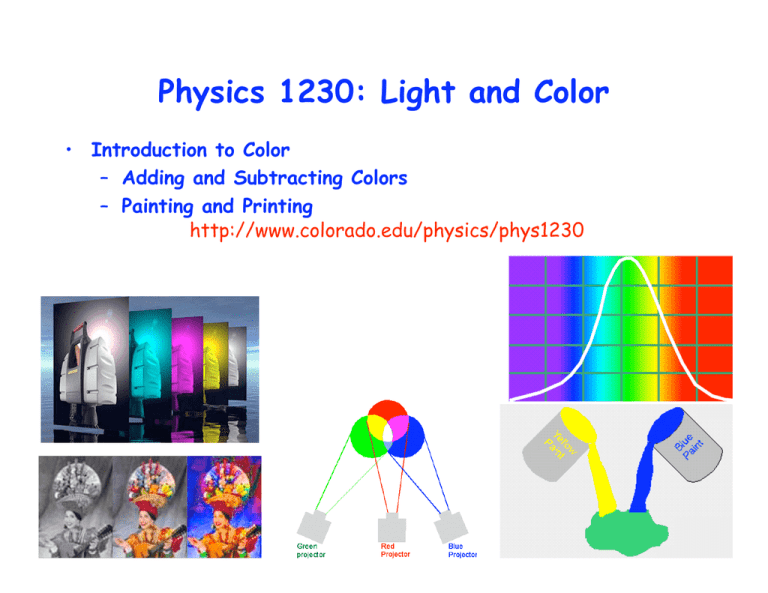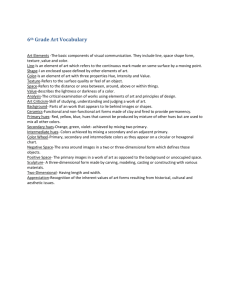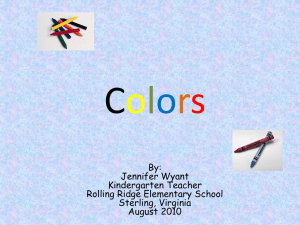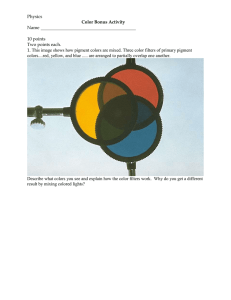Color I
advertisement

Physics 1230: Light and Color • Introduction to Color – Adding and Subtracting Colors – Painting and Printing http://www.colorado.edu/physics/phys1230 COLOR • Spectral and non-spectral colors • Intensity distribution curve • Intensity, hue, and saturation • Color tree • Additive primaries: R, G, and B • Subtractive primaries: C, M, and Y • Chromaticity diagram • Color mixing: addition and subtraction • Non-ideal colors • Light sources, color temperature • Inks, paints, and watercolors • Halftones What can we see? FOUR PRIMARY COLOR GROUPS Additive colors are created with light. You project a red light through a red screen or on a monitor or television. The additive primaries are red, green and blue (RGB). If you combine red, green and blue light you get white. Subtractive colors apply to print and pigment. In this case color exists because the pigment absorbs some light rays and reflects others. If we use red paint the pigment absorbs or subtracts all light rays other than red, which it reflects back to the eye. The subtractive primaries are magenta, yellow, cyan and black (CMYK). If you combine M, Y & C you get black. Artist’s primaries consist of red, yellow, and blue. From these primary colors the secondary colors orange, green and purple can be mixed from combinations of two primaries. The result when all three primaries are mixed is black Psychological colors consist of red, yellow, blue, green and the achromatic pair, black and white. This is the group we were taught as children. All colors can be described verbally as a mixture of these four psychological primaries. http://www-cvrl.ucsd.edu/ COLOR MIXING http://micro.magnet.fsu.edu/primer/java/scienceopticsu/primarycolors/additiveprimaries/index.html http://micro.magnet.fsu.edu/primer/java/scienceopticsu/primarycolors/subtractiveprimaries/index.html http://micro.magnet.fsu.edu/primer/java/scienceopticsu/primarycolors/colorfilters/index.html MIXING COLORS Where do we see a mix of the primary colors in everyday life? The images on our television sets and computer monitors are composed of tiny beams of red, green, and blue light. These are the ADDITIVE PRIMARIES. They are called additive primaries because we can make most colors from them. The colors in our clothes are made from dyes whose primary colors, however, are cyan, magenta, and yellow. These are the subtractive primaries. http://acept.la.asu.edu/PiN/mod/light/colorspectrum/pattLight3Obj1.html METHODS OF ADDING COLORS 1. ADDITION OF ILLUMINATION: Examples are stage lighting and 3color TV projection. Projected colors overlap. 2. PARTITIVE MIXING: Examples are TV screens, laptop screens, or tightly woven fabric. These are closely spaced dots of colors. 3. TIME MIXING: Examples are rotating color wheels. 4. BINOCULAR MIXING: Here a different color is sent to each eye, and the colors mix in the brain. Partitive Mixing Example – Butterfly Wings COLOR MIXING IN LIGHT Color that is mixed using light responds differently than in pigment. The primary colors, those that are the basis for all others and cannot be made from mixed color, are red, green and blue-violet. From these primary colors the secondary colors magenta, turquoise and yellow can be mixed from combinations of two primaries. The result when all three primaries are mixed is white. This occurs because all the colors of the spectrum are present in white light. There is the opposite result when all primaries are mixed in pigments. One good example of color mixing in light occurs in video and computer monitors. You may not notice this in your computer because color in computer graphics programs are calibrated to react like pigment. Also check out http://www.yorku.ca/ eye/toc-sub.htm http://www.saumag.edu/art/studio/chalkboard/c-pigmix.html SPECTRAL COMPLEMENTS The complement of a color is the color you would add to get white Complement of red = blue + green = cyan Complement of blue = red + green = yellow Complement of green = blue + red = magenta So WHITE = R + G + B = B + Y = G + M = R + C Colors made by mixing are not as saturated because they contain a broader color range http://acept.la.asu.edu/PiN/mod/light/colorspectrum/pattLight3Obj1.html CONCEPT QUESTION - SPECTRAL COMPLEMENTS Complement of green is A. Red plus blue B. Magenta C. Yellow http://acept.la.asu.edu/PiN/mod/light/colorspectrum/pattLight3Obj1.html Look around the room - at other people's dress, walls, etc.. Why are these things colored the way they are? Why do we see yellow in bananas, green in grass, or black in an evening gown? COLOR In white light, an object that looks red, for instance, is absorbing all the other wavelengths (colors) of the white light and letting only the red reflect back to your eyes. An object that looks black is absorbing all the wavelengths of light and allowing none (or almost none) to reflect into your eye. Then why can we see it at all, you may ask? Some of the light may reflect off the black object if it is shiny, in which case not all wavelengths are being absorbed, some are simply reflected like a mirror. So our banana is yellow because the properties of the skin of the banana are such that it absorbs all the other colors except yellow (until, of course, it overripens and then it starts absorbing all the colors!) http://acept.la.asu.edu/PiN/mod/light/colorspectrum/pattLight3Obj1.html COLOR MIXING USING PAINTS COLOR MIXING http://micro.magnet.fsu.edu/primer/java/scienceopticsu/primarycolors/additiveprimaries/index.html http://micro.magnet.fsu.edu/primer/java/scienceopticsu/primarycolors/subtractiveprimaries/index.html http://micro.magnet.fsu.edu/primer/java/scienceopticsu/primarycolors/colorfilters/index.html COLOR MIXING IN ART Color that is mixed in pigment responds differently than in light or optical color mixing. The primary colors, those that are the basis for all others and cannot be made from mixed color, are red, yellow and blue. From these primary colors the secondary colors orange, green and purple can be mixed from combinations of two primaries. The result when all three primaries are mixed is black. This is the opposite of the result when all primaries are mixed in light. Color in pigment is reliant on light. It depends on the reflection of the specific color. White light is a mixture of all colors and when a color is present only that color is being reflected. For example, in red pigment, all other colors except red are absorbed. Red is reflected and this is what the eye perceives. http://www.saumag.edu/art/studio/chalkboard/c-pigmix.html COLOR MIXING USING PAINTS • Hypothetical reflectance functions for blue and yellow paints. Blue paint reflects most light at the short wavelengths and absorbs light of long wavelengths. Yellow paint reflects most light at long wavelengths and absorbs light at short wavelengths. Because blue paint and yellow paint both reflect middle (green-appearing) wavelengths when blue and yellow paint are mixed together, the mixture appears green. the reflectances add! PAINTS • Paints consist of pigment particles embedded in a liquid vehicle. • The vehicle may be clear or it may contain a dye. • Pigment flakes can be partially transparent and work by selective absorption, or opaque and work by partial reflection. The size of the particle makes a difference - smaller particles transmit more and absorb less. • Photographs and paints can have a glossy or matte finish. Glossy surfaces are smooth and reflect part of the light specularly (like a mirror), and part of the light diffusely. Wet surfaces usually look glossy, because they are smooth. COLORS IN ART Jean-Honoré Fragonard mixed many colors to paint A Young Girl Reading (1776) DESCRIBING COLOR Hue, Saturation and Value All colors and tones have an inherent hue, saturation, and value (HSV). Hue is the color being described, such as yellow, purple, or green. Saturation, also referred to as chroma, is the intensity or purity of the color. (For example, 100% red would be vivid red whereas 10% would be light pink.) Value is the relative lightness or darkness of the color. Value is also used to describe tonal values that contain no hue (grayscale). http://www.tu-harburg.de/rzt/tuinfo/ periph/drucker/Color_Reproduktion/ CHARACTERISTICS OF COLOR - SATURATION • SATURATION: This is the purity of a color. An unsaturated color contains other colors of less intensity. -100, +20, +100 adding White to any color makes it less saturated! INTENSITY DISTRIBUTION CURVES The intensity distribution curve gives the percent of each wavelength reflected from a surface 100% 400 500 600 700nm EXAMPLE: reflection from a RED surface that reflects 100% of red but 0% of GREEN or BLUE This is saturated red INTENSITY DISTRIBUTION CURVES The intensity distribution curve gives the percent of each wavelength reflected from a surface 100% 400 500 600 700nm EXAMPLE: reflection from a RED surface that reflects 100% of red mixed with some YELLOW This is unsaturated red CHARACTERISTICS OF COLOR - SATURATION • SATURATION: This is the purity of a color. An unsaturated color contains other colors of less intensity. 100% 100% 400 500 600 700nm Unsaturated yellow 400 500 600 700nm Saturated yellow INTENSITY DISTRIBUTION CURVES The intensity distribution curve gives the percent of each wavelength reflected from a surface 100% EXAMPLE: reflection from a CYAN surface that reflects GREEN and BLUE but not red 400 500 600 700nm CHARACTERISTICS OF COLOR – Chromaticity Diagram • SATURATION: This is the purity of a color. An unsaturated color contains other colors of less intensity. adding White to any color makes it less saturated! COLOR FILTERING http://micro.magnet.fsu.edu/primer/java/scienceopticsu/filters/absorption/index.html SUBTRACTIVE MIXING • Filters work by absorbing part of the white light sent through them. • Example: a red filter absorbs blue and green thus leaving red. • So the TRANSMISSION curve of a red filter looks like the REFLECTANCE curve of a red surface. (projected light beams) (using filters) SUBTRACTIVE PRIMARIES • It is useful to think of cyan, magenta, and yellow in the following way • Cyan = filter passes green and blue = white - red = “minus red” • Magenta = filter passes red and blue = white - green = “minus green” • Yellow = filter passes green and red = white - blue = “minus blue” http://www.explorescience.com/activities/Activity_page.cfm?ActivityID=37 http://home.att.net/~B-P.TRUSCIO/SPECTRUM.htm ADDING SATURATED FILTERS • What happens if we combine a red filter and a blue filter? What color is transmitted? • The combination passes nothing because the red filter only allows red through, and the second does not pass red, so the combination passes nothing. ADDING USING TRANSMISSION CURVES • What happens if we combine a cyan filter and a green filter? What color is transmitted? • The combination passes green because cyan filter + green filter = white - red + (- blue - red) = green In other words, what goes through two filters must be under the transmission curves of both (their overlap). 100% 100% 400 500 600 700nm 400 500 600 700nm Optical Cast Plastic Color Filters • The transmission characteristics of filters vary widely. Here are the transmission curves of the large plastic filters shown in class: the Green and Blue filters let through quite a lot of Red light! Kodak Wratten Gelatin Filters • These expensive filters have much better transmission characteristics. • In this case, the Blue filter truly only transmits Blue light! NON-IDEAL COLORS – a Color Chart Many filters and dyes are unsaturated - so the results on addition are difficult to predict. Sometimes color charts help. Does the chart illustrate A. Additive color mixing? B. Subtractive color mixing? http://www.lynda.com/hexh.html NON-IDEAL COLORS So brown is a mixture of ? A. Unsaturated red and unsaturated green B. Black and red C. Dark orange http://www.lynda.com/hexh.html What do all those letters mean in the Color index? The RGB values are given as 3 pairs, in hexadecimal (base 16) notation: 0123456789ABCDEF For example, hex FF = 255 pure Red COLOR MIXING WITH ADDITIVE PRIMARIES The color on the left was produced by instructing the computer to activate 94 units of red and 62 units of green. This mixture of pixels undoubtedly produces a color which appears orange. Similarly, to get green, we mix blue and yellow. Non-spectral colors do not follow simple rules. The color on the right was produced by cutting the activation that produced the orange in half. On the right the activation is 47 units of red and 31 units of green. Roughly 2 parts red and 1 part green. Does the color on the right appear brown to you? If it does you now understand that brown is really dark orange. http://www.yorku.ca/eye/toc-sub.htm MORE COLOR MIXING The information entered into the computer to generate the color on the left was 250 units of red and 250 units of green. On the right the information was 50 units of red and 50 units of green. You undoubtedly see the color on the left as yellow and the one on the right as olive or olive green. Olive is a very dark yellow. http://www.yorku.ca/eye/toc-sub.htm GRAY FILTERS • Gray filters absorb all colors equally. So they can be used as white light filters to photograph bright objects (e.g. the sun). • They are also called NEUTRAL DENSITY FILTERS. • By combining two neutral density filters, each with transmission of 50%, how much light will the combination pass? http://www.schneideroptics.com/filters/list/5/nd2.html LIGHT SOURCES - COLOR TEMPERATURE • Light bulbs, the sun, street lamps, candles, and lasers all emit light of different colors. • For some sources such as a hot filament in a light bulb, or the sun, the colors emitted depend on the temperature. Cooler bulbs have more red for example than hotter bulbs. • Temperature is measured in Kelvin: Temp. in K = °C + 273 So Room Temp. = 20°C = 293 K • T(sun) ≈ 5000 K has lots of blue; T(tungsten lamp) ≈ 2850 K (looks orange, less blue); • T(candle) ≈ 1800 K (looks red, almost no blue) http:// www.phy.hw.ac.uk/ ~peckham/ envphy_4/ basic_principles!/ black_body.html LIGHT SOURCES - COLOR TEMPERATURE http://phet.colorado.edu/new/simulations/sims.php?sim=Blackbody_Spectrum Light Sources – Photographic Film is sensitive to Color Temperature daylight-balanced (5000 K) Fujichrome Velvia film photographed indoors under tungsten illumination tungsten-balanced (3200 K) Fujichrome 64T film photographed in natural sunlight http://micro.magnet.fsu.edu/optics/lightandcolor/colortemp.html LIGHT SOURCES - COLOR TEMPERATURE Tiffen 67mm 80A Cooling Conversion Filter Sunlight, daylight, incandescent, fluorescent, and other artificial light sources all have color characteristics that vary significantly. Filters give you better images by adjusting for these light variations. Film and video are rated for a particular color temperature such as that of daylight or tungsten light. Filters are used to correct differences in color temperature between the recording medium and the light source. SPECTRAL AND NON-SPECTRAL COLORS Spectral colors: Red, orange, yellow, green, blue, violet Non-spectral colors: Brown, pink, cyan, and magenta Cyan is a mixture of blue and green Magenta is a mixture of red and blue METAMERS METAMERS are colors that look the same but that arise from different intensity curves The left curve is a yellow, from a mixture of red and green The right curve is a pure yellow - a narrow band around 600nm 100% 100% 400 500 600 700nm 400 500 600 700nm METAMERS 100% White is an equal mixture of red, green and blue. What other intensity curve would give white light? 400 500 600 700nm This is one example of a METAMER CONCEPT QUESTION - METAMERS White is an equal mixture of red, green and blue. 100% What is another metamer for white light? A. Red and cyan B. Cyan, magenta and yellow C. Blue and yellow 400 500 600 700nm




